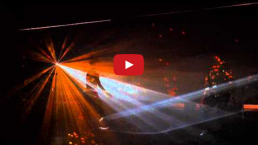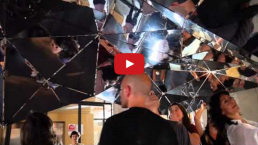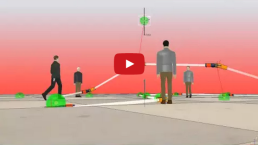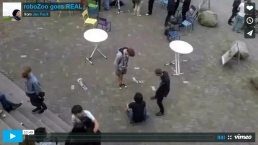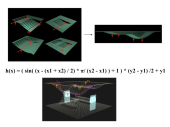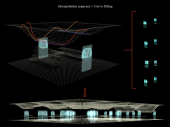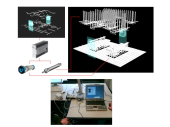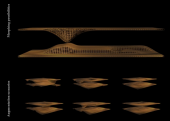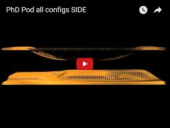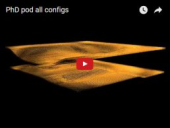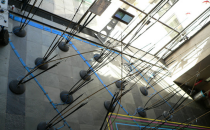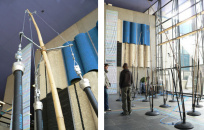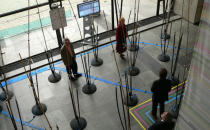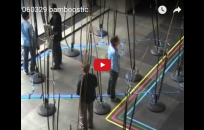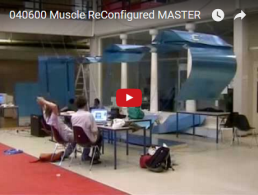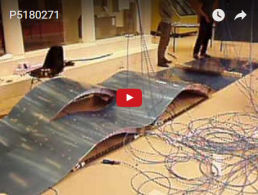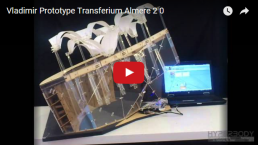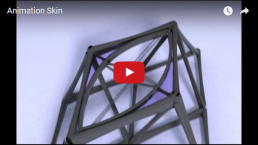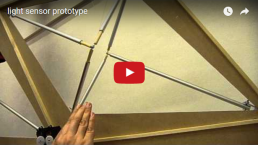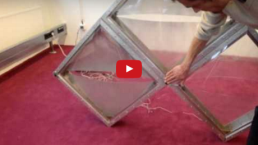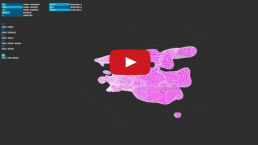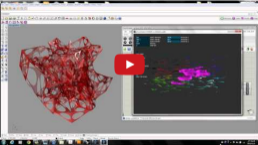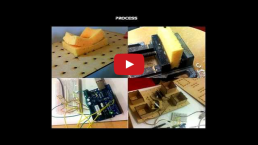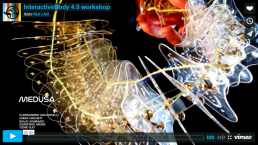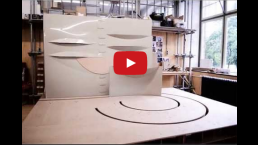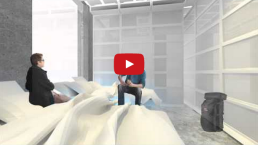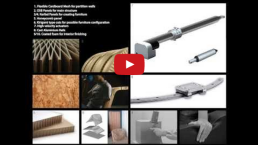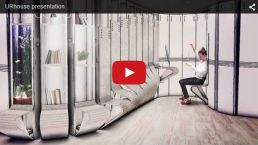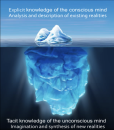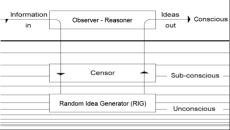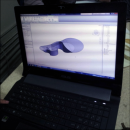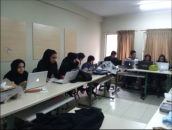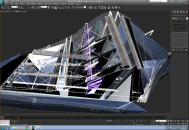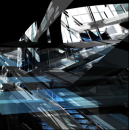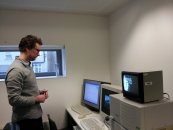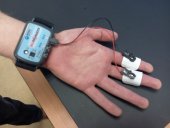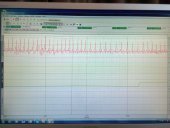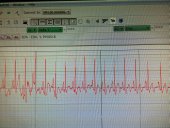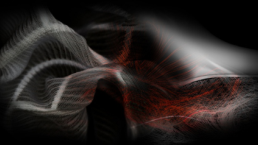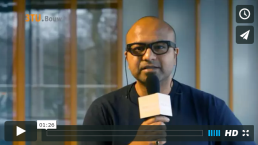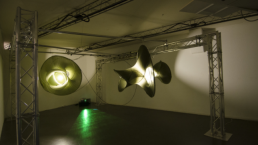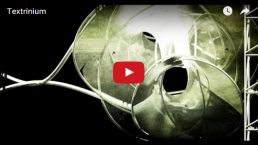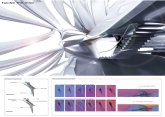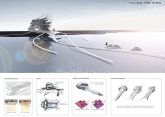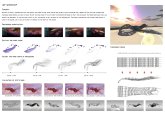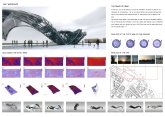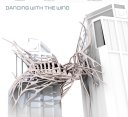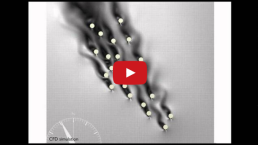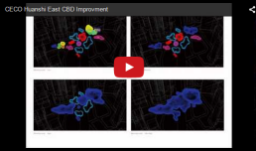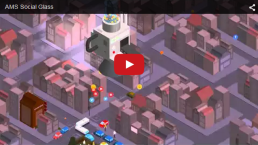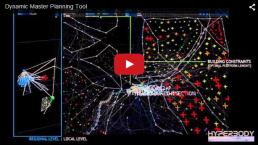-
- Scalable Porosity
- Adaptive Environments
- Kite-powered Design-to-Robotic-Production
- Fibrous Smart Material Topologies
- S.M.A.R.T Environments
- Robotic Building
- METABODY
- --- METABODY 1st EVENT
- --- METABODY 2nd EVENT
- --- Hyperbody update 02-2014
- --- Hyperbody Msc2 prototypes
- --- Ambiguous Topology 07-2014
- --- Reflectego & RoboZoo 07-2014
- --- The Hyper-loop
- --- Nervion, Textrinium & [S]caring-ami 07-2015
- SynSerre
- Robotic Architecture
- Automotive Complex
- Space-Customizer
- InteractiveWall
- iLITE
- Manhal Oasis Masterplan
- Muscle NSA
- protoCITY 2005+
- Virtual Operation Room
- Digital Pavilion
-
-
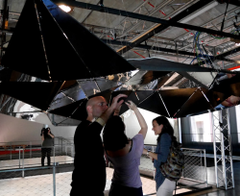
- Reflectego, 1:1 real-time interactive prototype, exhibited in Madrid 2014
-
- Projects
- S.M.A.R.T. Environments
- Project leader
- Dr. Nimish Biloria
- Project team
- Kas Oosterhuis, Jia Rey Chang, Veronika Laszlo, Xin Xia, Ali Reza Mahdizadeh, Han Feng, Achilleas Psyllidis
-
-
S.M.A.R.T. Environments
S.M.A.R.T. is an acronym for Systems & Materials in Architectural Research and Technology. As a research umbrella, S.M.A.R.T. Environments interrogates the intricate relationship between information systems and associative material formations. This interrogation is deeply rooted in exploring novel interdisciplinary design strategies and nonlinear processes for developing generative meta-design systems. These are used to conceive multi-scalar Performance Driven Architectures and Real-Time Interactive Environments. The resultant spatial outputs are hybrids, which evolve from the creative fusion of Ubiquitous computing, Parametric design and Material computing. Associated experiments spanning from the Micro to the Macro scales, focus on developing context aware spatial eco-systems embedded with sensing, actuation and control protocols enhanced with engineered computing elements and performance driven material aggregations. S.M.A.R.T. environments thus cover the following scales of operation:
- S.M.A.R.T. > Materials
- S.M.A.R.T. > Computing
- S.M.A.R.T. > Products/Installations
- S.M.A.R.T. > Buildings
- S.M.A.R.T. > Cities
Such environments are able to respond/communicate with People, Activity and Environmental Context based information in an intelligent and learned manner with a focus on enhancing user comfort & awareness levels while sustainably producing/channeling energy and optimally organizing materials. Such context aware environments thus embody sensing, thinking and acting as an intrinsic part of their make-up. Considering this Systems and Materials context, the aforementioned S.M.A.R.T. environment scales of operations are strategically explored via the following four research strands:
- Interactive Architecture Systems
- Interaction models and Cognitive Systems
- Material Systems and Performative Architecture
- Smart Cities
The relevance of these research strands in the contemporary information rich era and their implications on the shaping of the Architecture Engineering and Construction (AEC) sector is substantial. The rate at which networked data connectivity between objects, machines and humans is omnipresent and is exponentially increasing has become a key indicator towards exploring such novel design and research paradigms within the AEC sector. This rate of connectivity in the form of the Internet of Things, will fundamentally transform how people will work through new interactions between humans and machines. It will combine the global reach of the Internet with a new ability to directly control the physical world, including machines, factories and infrastructure that define the modern landscape. Such data driven synergistic environments bind architectural space and the human counterpart in a behavioral dialogue promoting real-time interaction. With the advancement in technology, such enhanced spatial environments, are now also increasingly being delegated the task of being more human. This implies acquiring a higher level of intelligence with attributes such as empathy, compassion, pro-activeness etc. becoming intrinsic qualities. It is thus rather crucial to understand how man perceives and experiences his coexistence with advanced machinic intelligence. Besides this, advancements in computational design and analysis tools and techniques have already begun challenging traditional modes of design. An Architectural Engineering flavor, which deals with advanced performance metrics and hyperlinked knowledge banks, is on the rise and is being heavily experimented with by the design fraternity. Performance at the social, structural, environmental and spatial front is thus underpinning contemporary design in praxis as well as academia. Developing fully parametric meta-design systems to enable today’s information architect to succeed in this competitive environment is thus gaining paramount importance. The emergence of a new material culture based on novel methodologies in both design thinking and materialization techniques is thus inevitable.
01. Interactive Architecture Systems research investigations explore the following aspects:
- Initiation of bi-directional communication between Architectural space/components, Embedded sensing, actuation, and control technologies, Contextual information and Human behavior.
- Multi-modal interactions, which associatively bind these domains into engaging and often pro-active modes of behavior.
- Internet of things and people, kinetic behavior as well as ambient intelligence and real-time communication of information at multiple-scales.
- Algorithm design and information theory
- Sensors design, calibration, motion detection, temperature, pressure sensors, accelerometers etc. to name a few
- Wireless and wired communication
- Parallel processing
- Undertaking Large scale commissioned installations as well as building scale dynamic facade systems.
- PhD candidate supervision
- Scientific Journals, Peer reviewed Conferences and Books based publications
- International lectures and panels.
Academic Research Projects:
EU Culture Grant: METABODY (Media Embodiment Tekne and Bridges of Diversity): started in July 2013, with the support of the European Commission (EU Culture). METABODY develops technologies, tools, techniques and devices that will be integrated in the first fully intra-active architectural pavilion, which will tour throughout Europe as an observatory of diversity and a laboratory of cultural diversity that will highlight the importance of non-verbal communication and embodied expressions as a primary substrate of nature cultures.
The project will elaborate a critique of the tendencies of both homogenization and preemption (adaptation to the new, assimilation of the new and programmed diversification) that information technologies operate in perceptions, affects, and subjective formations, where the irreducible and changing differences of embodied expressions and relations are reduced to linear patterns of simulation and standardized processes of media contagion, within a mechanistic tradition where movement is reduced to measurable coordinates.
At the same time new concepts and pragmatics of space-time, relations, corporeality, cognition, perception and affection will be elaborated for new technological paradigms exceeding mechanism and computation, that will take into account movement as multiplicities of intracorporeal sensations and affections irreducible to localizable points and trajectories, to measurable coordinates of space-time or form-pattern.
Explore more >> http://www.metabody.eu
Explore more >> http://www.hyperbody.nl/research/projects/metabody/
Explore more >> http://www.i-m.mx/Biloria/IM_Biloria/metabody
Scales of operation:- S.M.A.R.T. Materials
- S.M.A.R.T. Computing
- S.M.A.R.T. Products/Installations
- S.M.A.R.T. Building/Automation
Exhibitions:
- Center for European Textile Innovation (CETI) (2016)
- Synthetic exhibition, Le Mans, France (2016)
- Dig It Science Exhibition, TU Delft, Netherlands (2015)
- Media lab Prado, Madrid, Spain (2015)
- Media lab Prado, Madrid, Spain (2014)
Adaptive Corporate Environments: The research work specifically operates on the outcome of a PACT analysis (people, activity, context and technology framework, conducted through interview sessions, on-site observations and literature reviews) thus developing a bottom-up componential understanding of typical office environments. This exhaustive analysis of spatial typologies, bio-rhythms of corporate offices and psychological associations/dissociations of employees working within such office environments, suggested an increasing need for customization of individual environments within otherwise static, rather insipid office shells. This need is catered to, by means of the research output: an adaptive (real-time interactive) spatial meta-system which can re-configure its physical, ambient and informational state to cater to varying activities being performed within office environments. An Inter-disciplinary approach synergistically binding the fields of computation (for data structuring and data processing), control systems (for developing sensing and actuating properties) and kinetic structures (for developing a dynamic skeletal framework), operates on the outcome (needs and desires of users) of the PACT analysis. Issues related to building automation, ease of operation, a non-taxing clarity of tangible content to be represented via designed interactive interfaces, the choice of media and various spatial configurations that a singular architectural space could inherit (or physically morph into) are thus identified.
This research work specifically resulted in developing a computation aided spatial meta-system (resultant software) to be instilled within office environments which allows its users to input their ambient, spatial and social preferences through a designed interactive user interface. This meta-system further processes the inputted data per user through its internal computational routines and space allocation algorithms once the user’s presence is tracked in real time (via wireless sensor networks). This internal data-processing results in real-time simulation and physical regulation as regards automated space allocation, spatial configuration (via actuator networks > real-time adaptability) and ambience augmentation (real-time lighting control) conforming to every individual user’s personal preferences.
Explore more >> http://www.i-m.mx/Biloria/IM_Biloria/phd-research
Scales of operation:- S.M.A.R.T. Computing
- S.M.A.R.T. Building/Automation
Bamboostik: Bamboostik is a swarm behavior based mechanized forest. In order to derive a meaningful sense of interaction from this mechanical forest, it was decided to develop a mutual interdependence between the environmental settings within which the installation would be positioned and the nature of actuation which each structure would be subjected to. Two sets of activities were specifically chosen for the project, the first being very natural: the movement of people in space, and the second one an artificially induced one: the movement of a goldfish in a water tank. These movement patterns were sensed in real-time and were used as a trigger the dynamics of the mechanized forest. An approach akin to a swarm was decided upon. This approach entailed that the kinetic behavior would be regulated in accordance with the proximity of people near each individual bamboo structure. The so called tree nearest to an individual will bend towards him/her the most and this bending movement will be replicated in a decreasing degree of bend angle by the surrounding trees. At times when there would be an absence of people in the field, the movement of the goldfish would substitute the interaction pattern. In order to materialize this vision, camera based tracking and programming every tree as an autonomous agent, which communicates its current state only to its immediate neighbor were extensively researched. The overall complexity of the interaction hence stems from the interaction between the agent population and the proximity of humans in their vicinity. Humans thus become a part and parcel of an intricate loop of intercommunication between themselves and the mechanized trees. Subject and object relationships dissolve and an active engagement via live behavioral interaction emerges.
Explore more >> http://www.i-m.mx/Biloria/IM_Biloria/academic-explorations
Scales of operation:- S.M.A.R.T. Computing
- S.M.A.R.T. Products/Installations
Exhibitions:
- Public Exhibition, GSM 2 Conference, TU Delft, Faculty of Architecture, Delft, Netherlands
Muscle Re-configured: The Muscle re-configured prototype was conceived as a three dimensional strip in space, programmed to respond to its occupants through its sensing (proximity and touch sensors), processing (graphical scripting for real-time output) and actuating (fluidic muscles) enhancements. The construct utilizes the properties of Hylite (a composite of Aluminum and Plastic) panel’s being bendable and the Fluidic muscle’s properties of being able to produce compression power to transform the otherwise hard edged (visually) spatial strip into soft luxuriant topologies. Each Hylite panel coupled with two fluidic muscles hence forms the basic unit of the strip. Subsequent panels are joined together to create a closed 3D loop, in the process creating a series of nodes (junctions where the panels join). These nodes, are linked in space in a highly interdependent manner and constantly exchange information (air pressure variations) with immediate neighboring nodes, thus behaving as a collective, to attain spatial reconfigurations. This dense network of nodes has two typologies: external and internal node typologies. The external (constituting fluidic muscles at the junctions) predominantly dealing with sets of sensors and actuators and the internal (corresponding air valves and their array sequence in the graphical script) dealing with computation and data processing elements. A rule based control algorithm developed in Virtools (gaming software) binds the two node typologies together to produce the desired data exchange and data output scenarios (amount of air pressure to be released to the fluidic muscle). The Muscle re-configured project, works componentially by means of cumulative coupling of the basic unit mentioned above. This combinatorial approach is utilized for developing specific behaviors (in terms of kinetic movements) giving rise to three distinct elements: the responsive floor, responsive ceiling and responsive wall.
Explore more >> http://www.i-m.mx/Biloria/IM_Biloria/academic-explorations
Scales of operation:- S.M.A.R.T. Materials
- S.M.A.R.T. Computing
- S.M.A.R.T. Products/Installations
- S.M.A.R.T. Building/Automation
Exhibitions:
- Public Exhibition, TU Delft, Faculty of Architecture, Delft, Netherlands
Smart Building skin systems: The Smart building skin systems explorations aim at developing real-time responsive, self-sustaining building skins. The idea stemmed from the fact that the maximum surface area of any built form which is exposed to the elements are its facade and roofing elements. Considering this fact, what if, these elements became smart and integrated novel structure + skin solutions which harvest energy as well as interact with the occupants of the building at the same time. Componential population of energy harvesters from sources such as wind, sun, rain etc. thus symbiotically designed to fulfil energy demands of each other (self-powering) by intelligently sharing the produced energy and then store excess energy for the building's usage. Kinetics and material systems play a big role within these explorations, where real-time physical adaptation of the components towards the elements maximized the energy gain. Analogue experiments to determine componential variations and associated impacts on issues such as visibility ratios, air filtration, active air exchange etc. lead to the development of computational algorithms, which further drive the operational logistics of the skins.
Explore more >> http://www.i-m.mx/Biloria/IM_Biloria/academic-explorations
Academic Workshops:
Throughout the years, the group has conducted various workshops, both national and international. These workshops are meant to provoke and challenge young designers to think from a subject-subject perspective wherein people, architectural components, environmental parameters and artistic expression merge to create networked real-time interaction scenarios. The workshops, operate on different agendas, exploring strategies within the domains of quantum architecture, performance driven design, interactive architecture, simulation driven design etc. The results of the workshop are intensively analyzed, prototyped and exhibited in different geographical locations. Parametric design, Robotics and CNC production techniques are utilized extensively during all the workshops. Some workshops have also resulted in 1:1 prototypes, which have been fabricated in collaboration with the industry. Seeking an active transition from theory to practice via computational design processes has been the main driving force behind these intensive workshops.
Selected workshops:- Fata Morgana, Warsaw, Poland
- Quantum point cloud workshop, Nanjing, China
- Quantum urban flux workshop, Harbin, China
- CECO, Delft, Netherlands
- Multi-Mod, Delft, Netherlands
- Inter-performing Environments, Delft, Netherlands
Explore more >> http://www.i-m.mx/Biloria/IM_Biloria/workshop-files.html
Scales of operation:- S.M.A.R.T. Materials
- S.M.A.R.T. Computing
- S.M.A.R.T. Products/Installations
- S.M.A.R.T. Building/Automation
Education:
Within the Hyperbody educational set-up, S.M.A.R.T design principles and their applications at various levels have been tested, prototyped and applied. These range from Smart building skin systems, Home automation such as interactive and adaptive interiors as well as large scale spatial adaptations based on activity patterns, ergonomics, group behavior, environmental context and demographic information. This agenda is experimented upon via various Studios and Workshops held within undergraduate and post-graduate programs at the TU Delft as well as other Institutes globally since 2004.
Explore more >> http://www.i-m.mx/Biloria/IM_Biloria/interperforming-environments
Explore more >> http://www.i-m.mx/Biloria/IM_Biloria/multimod
Scales of operation:- S.M.A.R.T. Materials
- S.M.A.R.T. Computing
- S.M.A.R.T. Products/Installations
- S.M.A.R.T. Building/Automation
Exhibitions and Interviews:
- Tiny Appartement, Slimme oplossingen voor kleine appartementen, Blauwhoed Developers, Rotterdam, Netherlands (2015)
- Dr. Nimish Biloria interviewed by CNN International; Interview: Future cities and smart home applications (2015)
- Dr. Nimish Biloria interviewed by Fast Company Daily; Interview: Real-time interactive home environments (2015)
- Dr. Nimish Biloria interviewed by RAI, Lighthouse, Italy; Interview: Documentary series on Robotics in Europe (2014)
Selected Publications:
- Chang. J, Biloria. N. Vandoren. D (2015); Ambiguous Topologies: From Interactive to Pro-active spatial environments, IEEE proceedings VISAP, pages: 7 – 13, Chicago, Illinois, USA (http://visap.uic.edu/2015/papers.html) Chang. J, Biloria. N. Vandoren. D (2015), Ambiguous Topologies: From Interactive to Pro-active spatial environments, IEEE proceedings VISAP, pages: 7 – 13, Chicago, Illinois, USA (Explore more >> http://visap.uic.edu/2015/papers.html )
- Biloria. N. (2015); Interactive Environments; an investigation into real-time responsive spatial systems, ICONARCH II, International Congress Proceedings, ISBN 978-975-448-205-8
- Next Generation Building Journal (2015); Special Edition on Info-Matter, Edited by Dr. Nimish Biloria and Matias del Campo: with contributions from Zaha Hadid Architects, Zwart and Jansma, Tom Wiscombe: Emergent, Marc Fornes: The Very Many and more:
Explore more >> http://www.ngbj.info/index.php/ngb-01-2015 - Biloria. N. (2014), Architecture Institute of Korea, ISSN 1225-1666, Article: Inter-performing morphologies, 2014
- Biloria, NM & Chang, J.R. (2013); Hyper-Morphology: Experimentations with bio-inspired design processes for adaptive spatial re-use. In R Stouffs (Ed.), Proceedings of the 31st International Conference on Education and research in Computer Aided Architectural Design in Europe (pp. 529-538).
- Biloria, Nimish and Chang, Jia-Rey (2012); "Digital physicality, physical Digitally," Proceedings of the 30th eCAADe Conference, Prague, Czech Republic, HyperCell: A Bio-inspired information design framework for real-time adaptive spatial components, Volume.2, pp.573-581.
- Biloria, N. (2012); Co-Editor, Book: Hyperbody, First Decade of Interactive Architecture, Jap Sam Publishers, Netherlands, ISBN-10: 9490322091, ISBN-13: 978-9490322090, August, 2012
- Biloria N. (2012); Interactive morphologies: An investigation into integrated nodal networks and embedded computation processes for developing real-time responsive spatial systems, Frontiers of Architectural Research Volume 1, Issue 3, September 2012, Pages 259-271
- Biloria, N. (2011); Author, Book: Interactive Corporate Environments: Developing real-time interactive corporate environments incorporating computational techniques [Paperback], VDM Verlag Dr. Müller Publishers, ISBN-10: 3639361350, ISBN-13: 978-3639361353
- Biloria, N. (2010); Interactive Bodies, Forward, Volume 110, ISSN 2153-7526, American Institute of Architects Publishers, USA, 2010, pp. 69-76
- Biloria, N (2009); A ubiquitous computing based interactive corporate office metasystem, Proceedings of Ubiquitous Computing Systems UCS 09 Conference, Beijing, China
- Biloria, N, Sumini, V. (2009); Performative Building Skin Systems: A Morphogenomic Approach Towards Developing Real-Time Adaptive Building Skin Systems, International Journal of Architectural Computing vol. 7 - no. 4, 2009, pp. 643-676.
- Biloria, N. (2009); Performative building skin systems, IEEE Explore, Computation World 2009 conference, Athens, ISBN 978-1-4244-5166-1, pp. 119-125
- Biloria, N. (2009); Developing an interactive architectural meta-system for contemporary corporate environments, SCROOPE 19, Cambridge architecture journal, Cambridge University press, Cambridge, UK, pp. 70-80
- Biloria, N. (2009); Inter-active spaces Indian architect and builder magazine, Special issue on Digital Architecture, Jasubhai Media, Mumbai, India
- Biloria, N (2008) Real-time interactive corporate environments, Proceedings of 2nd Symposium on Systems Research in the Arts and Humanities (SSRAH): "On Interaction/Interactivity in Music, Design, Visual and Performing Arts", Baden Baden, Germany, pp. 121-125
- Biloria, N, Oosterhuis, K. (2007); Organic interactions through pro-active architecture: The muscle projects, Special issue of ACM magazine, Organic user interfaces, ISSN: 0001-0782, ACM Publishers, New York, USA, pp. 70-78
- Biloria, N (2007) Spatializing real-time interactive environments, Proceedings of Tangible and Embedded Interaction (TEI 07) conference, Baton Rouge, Louisiana, USA, ISBN: 978-1-59593-619-6, pp. 215-222.
PhD researchers:
- Jia Rey Chang (Ongoing) > Promotor: Ir. Kas Oosterhuis, Co-Promotor: Dr. Nimish Biloria
- Dr. Tomasz Jaskiewicz (Completed in 2013) > Promotor: Ir. Kas Oosterhuis, Co-Promotor: Dr. Nimish Biloria
- Dr. Nimish Biloria (Completed in 2007) > Promotor: Ir. Kas Oosterhuis & Dr. Leen van Duin
02. Interaction models and Cognitive Systems based research investigations explore the following aspects:
- Inter-disciplinary research establishing scientific linkages between the disciplines of Architecture, Interaction Design, Computational Design, Cognitive Sciences and Experimental Psychology.
- Embodied, embedded, enactive, extended and affective modes of cognitive models as well as theories of emergent aesthetics and proprioception
- Operating on a tripartite approach involving distinct behavioral, electrophysiological (neuro-scientific), and survey sampling methods.
- PhD candidate supervision
- Scientific Journals, Peer reviewed Conferences and Books based publications
- International presentations
- Collaboration with International and National Universities
Explore more >> http://www.i-m.mx/Biloria/IM_Biloria/iacs
Scales of operation:- S.M.A.R.T. Computing
- S.M.A.R.T. Products/Installations
ALIEN, workshop, Azad University, Iran, focusing on geometric alterations to a traditional form in order to expand perceptual and cognitive modes within the otherwise saturated designer"s mind. (Alireza Mahdizadeh, Iran, 2013)
Conducting EEG scans while the participants observes videos embodying different spatial complexities (Alireza Mahdizadeh recording data at the Goldsmith University, Department of Psychology, London, UK)
Experiments using the Leapmotion device in combination with the app: Touchless for tracking hand movement, while the BIOPAC system records data of skin conductance and heart rate (Xin Xia recording data at the Leiden University University, Department of Psychology, Cognitive Psychology Unit, Leiden, NL)
Publications:
- Alireza Mahdizadeh Hakak, Joydeep Bhattacharya, Nimish Biloria & Armaghan Ahmadi Venhari (2015); The Proto-Fuse project: methods to boost creativity for architects, International Journal of Design Creativity and Innovation, DOI: 10.1080/21650349.2015.1021838
- Xia X, Biloria N, Hommel B. (2014); Embodied Aesthetics, Proceedings of the 1st International conference on Aesthetics and the embodied mind, Article: From film studies to interaction design, Editor: Alfonsina Scarinzi, Brill publishers, Leiden, Boston.
- Mahdizadeh Hakak, A, Biloria, NM & Rahimi, MR (2012); Implementing unconventional virtual environments for enhancing creativity in architecture pedagogy. International Journal of Virtual and Personal Learning Environments, 3(4), 41-52
- Xin Xia and Biloria Nimish (2012); A 4EA Cognitive approach for rethinking the human in Interactive Architecture, Conference Proceedings: Rethinking the Human in Technology-Driven Architecture, Editors: Maria Voyatzaki; Constantin Spiridonidis, ISBN: 978-2-930301-53-2
- Mahdizadeh Hakak, A & Biloria, NM (2011); New perception of virtual environments, Enhancement of creativity: Increasing dimension of design starting point. In T Zupancic, M Juvancic, S Verovsek & A Jutraz (Eds.), eCAADe 2011: Proceedings of the 29th conference on education and research in computer aided architectural design in Europe (pp. 967-975). Ljubljana: eCAADe, Faculty of Architecture, University of Ljubljana.
PhD researchers:
- Xin Xia (Ongoing) > Promotor: Dr. Bernhard Hommel, Co-Promotor: Dr. Nimish Biloria
- Ali Reza Mahdizadeh (Ongoing) > Promotor: Ir. Kas Oosterhuis, Co-Promotor: Dr. Nimish
03. Material Systems and Performative Architecture based research investigations focus on the following:
- Generating bottom-up, performance embedded aesthetic via non-linear fully parametric modes of design and engineering thinking
- Associatively binding Social dynamics, Spatial affordance, Environmental parameters as well as Structural dynamics via simulation driven design techniques for the generation of novel morphologies
- Performance driven formal complexity, parametric geometry, structural ingenuity and social inclusivity
- Material engineering
- PhD candidate supervision
- Scientific Journals, Peer reviewed Conferences and Books based publications
- International and National lectures
Scales of operation:
- S.M.A.R.T. Materials
- S.M.A.R.T. Computing
- S.M.A.R.T. Buildings/Energy
Academic Research Projects:
Fibrous Smart Material Topologies: The project is a truly inter-disciplinary initiative for the 'designed engineering' of heterogeneous fibres with variable material behaviors to create real-time responsive interior environments (furniture systems). These smart furniture systems will embody properties of real-time adaptive temperature control, real-time structural adaptability and real-time physiological support of the human body. These properties shall be fully self-regulated (devoid of external power sources) via engineering multi-layered fibre compositions, which, can sense the forces exerted by the human body and accordingly alter their physical properties. The scale of operation is chosen deliberately, considering the time-span of one year within which we will produce of a fully operational 1:1 physical prototype and scientific material-research guidelines. A research through design approach with 3 iterations: working on the yarn (U Twente + EURECAT), textile (TUE) and product (TUD) levels shall be adopted in this research. Each iteration will consist of the development of a prototype, the creation of future usage scenarios + business possibilities and a workshop to envision future requirements. In this project, prototypes and material output will be co-designed with material scientists, architects, textile and industrial designers and will be used to assess 1) design challenges, 2) business opportunities, and 3) technical feasibility of scalable multi-performative interior systems for applications such as healthcare and future office environments.
Explore more >> http://www.hyperbody.nl/research/projects/fibrous-smart-material-topologies/
Scales of operation:- S.M.A.R.T. Materials/Textile
- S.M.A.R.T. Computing
- S.M.A.R.T. Products/Furniture
Exhibitions/Lectures:
- Dr. Nimish Biloria; 2015, Smart Textiles Association, University of Boras, Sweden, Lecture: Inter-performing Environments
- Dr. Nimish Biloria; 2015, ArcInTex Conference, Technical University Eindhoven, Lecture: Smart textiles and Interactive Architecture
Textrinium (Smart Textiles): The main appearance of the structure is based on the mathematical embedded minimal surface discovered in 1982 by Celso José da Costa. The topology is created by puncturing a compact surface, therefore becoming a finite topology. The current design is a topologically thrice-punctured torus which is deformed until the planer end becomes catenoidal. The topology can be described using the Weierstrass zeta and the Weierstrass elliptic functions. The name of the project is Textrinium based on the interweaving of different components within the textile, architecture and mathematical geometry. Textrinium is a textile based structure that interacts with its surroundings by change in kinetic energy, shade shifting of colors by differentiating in resistance and integrated sensors like ultrasonic and conductive wire. All the used components are part of the same knitted fabric. The structure is supported by an internal skeleton composted out of glass fiber. Extensive research in material systems, topology optimization, stress and deformation simulation within fabrics, weaving patterns and fiber directionality, integrating (knitting) sensing, sewing techniques exploration, actuation and control systems within the textiles, thermo-chromic textile based applications, phosphorescence applications and computation numerically controlled fabrication are part of the research and design workshop. Textrinium is the outcome of a dedicated collaboration between Hyperbody (Dr. Nimish Biloria) and the University of Boras, School of Textiles, Sweden (Dr. Delia Dumitrescu)
Explore more >> http://www.hyperbody.nl/research/projects/nervion-textrinium-scaring-ami-07-2015/
Scales of operation:- S.M.A.R.T. Materials/Textile
- S.M.A.R.T. Computing
- S.M.A.R.T. Products/Installation
Exhibitions:
- International Festival of Technology, TU Delft (2016)
- Center for European Textile Innovation (CETI) (2016)
- Synthetic exhibition, Le Mans, France (2016)
- Delft Science Centre, Netherlands (2015)
- Media lab Prado, Madrid, Spain (2015)
Academic Workshops:
Throughout the years, the group has conducted various workshops, both national and international. These workshops encourage subtle yet reinforcing modes of understanding the concepts behind associative thinking and geometric complexity. Multi-optimization, Quantum architecture and parametric design driven performative spatial experiments have thus been conducted extensively. The workshops, operate on different agendas, exploring strategies within the domains of quantum mechanics, performance driven design, interactive architecture, simulation driven design etc. The results of the workshop are intensively analyzed, prototyped and exhibited in different geographical locations. Parametric design, Robotics and CNC production techniques are utilized extensively during all the workshops. Some workshops have also resulted in 1:1 prototypes, which have been fabricated in collaboration with the industry. Seeking an active transition from theory to practice via computational design processes has been the main driving force behind these intensive workshops.
Scales of operation:- S.M.A.R.T. Materials/Textile
- S.M.A.R.T. Computing
- S.M.A.R.T. Products/Installation
- S.M.A.R.T. Buildings/Energy
Quantum Point Cloud Workshop, Nanjing, China (Tutors: Han Feng and Dr. Nimish Biloria)
Quantum Urban Flux Workshop, Harbin, China (Tutors: Han Feng and Dr. Nimish Biloria)
<
Publications:- Biloria. N. (2015); Editor, Info-Matter, Next Generation Building Journal, Baltzer Science Publishers, Amsterdam, Berlin, ISSN: 2213-4425, e-ISSN 2213-4433, (http://www.ngbj.info/index.php/ngb-01-2015)
- Biloria, N.(2014); Next Generation Building journal, Baltzer Science Publishers, Article: Performance driven generative design systems, Volume 1, No. 1, 2014, ISSN 2213-4425, e-ISSN 2213-4433
- Biloria, N (2013); Next Generation Building journal, Balthazer Science Publishers, Article: Performance driven generative design systems (approved for publication), 2013
- Mostafavi, S, Morales Beltran, MG & Biloria, NM (2013); Performance driven design and design information exchange. In R Stouffs & S Sariyildiz (Eds.), Proceedings of the Education and research in Computer Aided Architectural Design in Europe (eCAADe) 2013 conference;(pp. 117-126). Delft, The Netherlands
- Biloria N (2013); Next Generation Building journal, Balthazer Science Publishers, Article: Performance driven generative design systems (approved for publication), 2013
- Biloria, N. (2013); Performance driven generative design pedagogy: Interfacing multi-agent simulation driven design techniques with environmental modelling methodologies in architectural education, ENHSA Conference: Computation, environment and architectural innovation, Napoli, Italy.
- Biloria, N (2012); Co-Editor, Book: Hyperbody, First Decade of Interactive Architecture, Jap Sam Publishers, Netherlands, ISBN-10: 9490322091, ISBN-13: 978-9490322090, August, 2012
- Biloria, N (2012); Co-Editor, Book: Hyperbody, First Decade of Interactive Architecture, Jap Sam Publishers, Netherlands, ISBN-10: 9490322091, ISBN-13: 978-9490322090, August, 2012
- Biloria N (2011); InfoMatters, a multi-agent systems approach for generating performative architectural formations; International Journal of Architectural Computing, Issue 03, Volume 09: September 2011 (205 - 222)
- Biloria N (2011); Interdisciplinary Process Driven Performative Morphologies: A Morphogenomic approach towards developing context aware spatial formations; V!RUS, No.6, Nomads.usp journal, Creation in Processes, ISSN: 2175-974.
- Biloria N (2011); InfoMatters, a multi-agent systems approach for generating performative architectural formations; International Journal of Architectural Computing, Issue 03, Volume 09: September 2011 (205 - 222)
- Biloria N. (2008); Interdisciplinary Process Driven Performative Morphologies: A Morphogenomic approach towards developing context aware spatial formations; V!RUS, No.6, Nomads.usp journal, Creation in Processess, ISSN: 2175-974.
- Biloria, N (2008); Morphogenomic architecture, An investigation into informatics oriented evolution of form, Proceedings of AEC 08 Conference, Antalya, Turkey, pp. 49-58, http://www.lboro.ac.uk/cice/conferences/AEC2008/
- Biloria, N (2008); Introduction article: Evolutionary computation, ACAADIA 2008, Silicone+Skin, ISBN: 978-0-9789463-2-6, Minneapolis, USA
- Biloria, N. (2006); Design Informatics, Architecture Annual 05-06 TU Delft, 010 Publishers, Rotterdam, The Netherlands
- Biloria, N, Oosterhus, K and Aalbers, C (2006); DESIGN INFORMATICS: (A case based investigation into parametric design, scripting and CNC based manufacturing techniques), CAADRIA2006 [Proceedings of the 11th International Conference on Computer Aided Architectural Design Research in Asia] Kumamoto (Japan) March 30th - April 2nd 2006, pp. 237-244
PhD researchers:
- Han Feng (Ongoing) > Promotor: Ir. Kas Oosterhuis, Co-Promotor: Dr. Nimish Biloria
- Sina Mostafavi (Ongoing) > Promotor: Ir. Kas Oosterhuis, Daily supervisor: Dr. Nimish Biloria
04. Smart Cities agenda explores the following:
- Urban Informatics: social and human implications of technology in cities
- Urban computing: Application of wireless networks, sensors, computational power, and Big data
- Development of both methodological and technological frameworks towards the co-evolution of ICT, distributed sensing networks, crowd sourcing as well as the development of physical interfaces for the urban environment.
- Linking heterogeneous data sets in order to extract knowledge applicable for user awareness, participatory governance and smart energy monitoring.
- User engagement, effective knowledge communication and participatory design systems.
- PhD candidate supervision
- Scie-ntific Journals, Peer reviewed Conferences and Books based publications
- International and National lectures and presentations
Scales of operation:
- S.M.A.R.T. Computing
- S.M.A.R.T. Cities
Exhibitions:
- Psyllidis, A, Bozzon, A, Bocconi, S & Titos Bolivar, C (2015). Social Glass - SAIL 2015: Spatial patterns in the use of social media. De Veranderende Stad Tentoonstelling ('The Changing City' Exhibition): Rokin, Amsterdam (2015, November 12 - 2015, November 14).
- Psyllidis, A, Bozzon, A, Bocconi, S & Titos Bolivar, C (2015). SocialGlass. AMS Partner Event: Amsterdam (2015, February 19).
- Psyllidis, A, Bozzon, A, Bocconi, S & Titos Bolivar, C (2015). SocialGlass: Urban analytics and decision-making through heterogeneous social data. TU Delft 173rd Dies Natalis: Exhibition of projects on Intelligent Cities: (2015, January 9).
- Psyllidis, A, Bozzon, A, Bocconi, S & Titos Bolivar, C (2014). SocialGlass. IBM Extreme Blue Expo: Amsterdam, IBM Headquarters (2014, September 12).
- Psyllidis, A, Bozzon, A, Bocconi, S & Titos Bolivar, C (2014). SocialGlass. Launch Conference, Shell Technology Center, Amsterdam: Amsterdam (2014, June 20).
- Psyllidis, A, Bozzon, A, Bocconi, S & Titos Bolivar, C (2014). SocialGlass - Your City through the Lens of Social Data. DIG-it! Research Exhibition of Innovative Projects: Delft, TU Delft Library (2014, November 11).
- Psyllidis, A, Bozzon, A, Bocconi, S & Titos Bolivar, C (2014). SocialGlass: A platform for urban analytics and decision-making through heterogeneous social data. IBM - TU Delft Collaborative Innovation Center Kick–off Event: TU Delft, Faculty EEMCS (2014, December 3).
- Psyllidis, A, Bozzon, A, Bocconi, S & Titos Bolivar, C (2014). SocialGlass: Your City through the Lens of Social Data. New Horizons Festival: European Researchers' Night: Rotterdam Erasmus MC (2014, September 26).
Image credits: Urban Informatics methodological framework for establishing associative linkages between heterogeneous datasets (Presentation by Achilleas Psyllidis and Dr. Nimish Biloria at The Smart Cities Convention, Aarhus University, Denmark)
Established Collaborations:
- AMS, Amsterdam, Netherlands (http://www.ams-amsterdam.com)
- Delft Social Data Science Lab, TU Delft, Netherlands (http://www.delftdatascience.tudelft.nl/about-dds/delft-social-data-science-lab-sands-lab/)
- Urban Systems and Environment (USE), joint research center between TU Delft and the South China University of Technology (SCUT)
Publications:
- Psyllidis, A, Ryan, D, Kem, O & Horrigan, M ROUTE - OWL s.l.. (2015); ROUTE - Route Ontology of Urban Transportation Entities [Dataset]. Retrieved Dec 01, 2015, from http://smartcity.linkeddata.es/datasets/datasets/labs.geodata.gov.grendataseturban-transportation-routes-athens.html
- Psyllidis, A & Biloria, NM (2014); OntoPolis: A semantic participatory platform for performance assessment and augmentation of urban environments. In s.n. (Ed.), 10th IEEE international conference on intelligent environments (pp. 140-147).
- Psyllidis, A & Biloria, NM (2013); Urban media geographies: Interfacing ubiquitous computing with the physicality of urban space. In J Geiger, O Khan & M Shepard (Eds.), Proceedings Media City 4 "Mediacities": International conference, workshops and exhibition (pp. 302-309). Buffalo, New York: University at Buffalo, State University of New York.
- Psyllidis, A & Biloria, NM (2013); The adaptive city: A socio-technical interaction-driven approach towards urban systems. In D Charitos, I Theona, D Dragona & C Rizopoulos (Eds.), Proceedings of the 2nd international hybrid city conference (pp. 371-378). Athens: University Research Institute of Applied Communication (URIAC).
PhD researchers:
- Achilleas Psyllidis (Ongoing) > Promotor: Ir. Kas Oosterhuis, Co-Promotor: Dr. Nimish Biloria
 Facebook/
Facebook/
 Twitter/
Twitter/
 RSS
RSS
